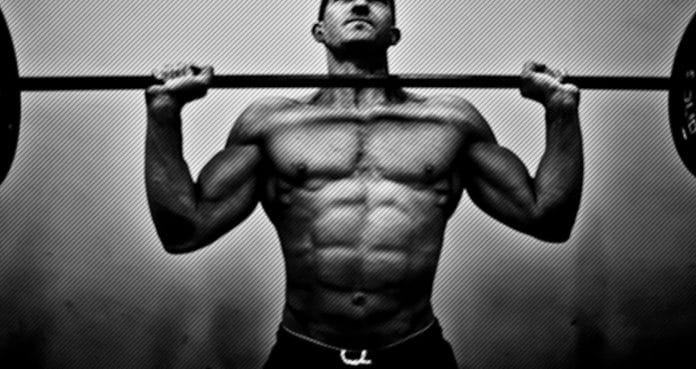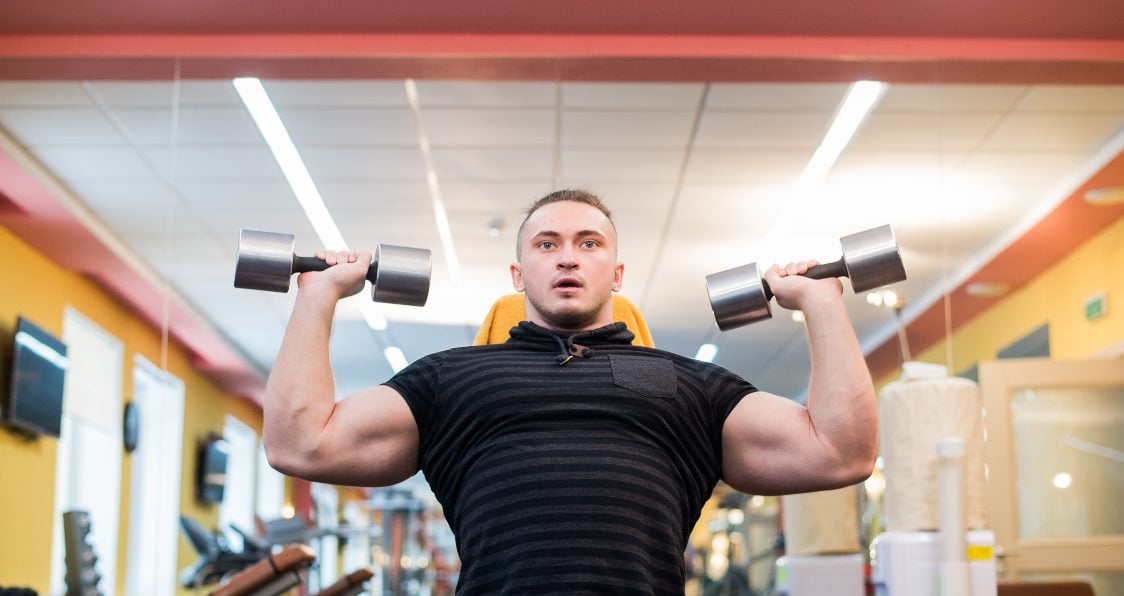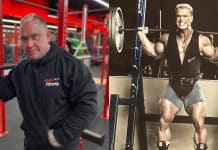
The seated barbell shoulder press removes your core and legs from the equation.
The seated barbell shoulder press is a highly effective exercise for developing shoulder muscles. This workout eliminates reliance on leg drive and emphasizes your shoulders to push the weight. Plus, Arnold Schwarzenegger incorporated seated presses into his golden era training so frequently that a variation is named after him, aka Arnold press.
The seated barbell shoulder press is a popular exercise and is done using barbells so that you can overload your muscles. This study shows that increasing load is one of the ways to build strength and enhance muscle growth during resistance training (1). Depending on your strength levels, you’ll also need a bench to sit on and a spotter to get you started.
Now while seated barbell shoulder presses are popular, many people don’t do this exercise with proper form. It’s important to know the pattern to follow when doing this and understand its function properly before adding it to your training. This guide outlines how to do this routine, its benefits for weightlifters, and some alternatives you could also try out. Also, you’ll learn what separates this one from the standing variation.
Techniques and Muscles Worked
The seated barbell shoulder press targets your delts and triceps. In this study, scientists noticed tricep activation in the seated barbell shoulder press when done on a bench (2). Unlike other overhead press routines involving your abs, having your back against a pad removes the core activation in this exercise but focuses more on the delts.
When doing the seated barbell shoulder press, you can’t lean back and arch excessively, which is a form of cheating many do in the standing variation. However, it’s still possible to make some mistakes when doing them if you don’t pay attention. Here’s a step-by-step guide showing you the proper form for this exercise to maximize your gains.
- Load a barbell with the appropriate weight, then rack it, sit on a bench, and grip the bar. This should be at a height where your arms are just about fully extended.
- Unrack the barbell using a pronated grip at a slightly wider than shoulder-width distance. Hold it just slightly in front of your head at shoulder level. This is your starting position.
- Brace your core and lower the bar to the top of your chest. Ensure you tuck your chin in to let the bar pass and inhale.
- Exhale and raise the bar above your head to return to the starting position and complete the rep.
- Repeat for as many reps as you desire.
Benefits
The seated barbell shoulder press is a great overhead press alternative for people with lower back pain. That’s because there is less tweaking of your lower back. It also isolates your shoulder better and offers a host of other benefits.
Shoulder Isolation
Seated barbell shoulder presses remove core stabilization and your legs. This allows you to zone in and build your shoulder muscles. As a result, this exercise primarily focuses on your anterior delts and recruits your lateral delts.
Better for Those with Knee or Hip Issues
If your hip or knees give you a twinge here or there, you might have some issues with a standing barbell shoulder press. This seated version removes those joints from the equation, allowing you to press heavier. It’s also a better alternative for those with lower back problems.
Great For Beginners
Beginners might find learning and doing a standing barbell shoulder press challenging. Seated barbell shoulder presses are less complex, so beginners can easily pick the proper form. This makes it a great starting option that you can use to build your strength before switching to the standing variation for full body gains.
Better Mind Muscle Connection
Not worrying about your leg or core during this routine is great for focus. As a result, you can build a great mind-muscle connection when doing this exercise. This study shows mind-muscle connection enhances muscle hypertrophy (3).
Seated Barbell Shoulder Press Alternatives
Overhead presses, such as the seated barbell shoulder press, are great for increasing the growth of your shoulder muscles. Here are some other overhead presses to build your shoulders that you can try.
Smith Machine Shoulder Press
The Smith machine shoulder press is an excellent option that helps you isolate your shoulders too. This exercise also requires less balance; however, it has a fixed bar path which might feel unnatural for your shoulder joints.
Standing Barbell Shoulder Press
As the name suggests, the standing barbell shoulder press is the standing alternative to the seated overhead barbell press. The major difference is the standing version involves your core and legs to lift the weight.
Seated Dumbell Shoulder Press
If dumbbells are easier to find free at your gym, then consider doing the dumbbell variation of this exercise. It also builds your shoulders, plus with this alternative, you can train each arm unilaterally and avoid muscle imbalances.
FAQs
Is seated barbell shoulder press good?
This exercise is a great way to build and strengthen your shoulder muscles. Check the above guide for more benefits and a breakdown of the muscles working.
How to do a proper seated barbell shoulder press?
To do this movement properly, you need a bench, barbells, and a way to rack your barbell. In the above guide, we share a step-by-step guide on how to do this routine with proper form.
What is the difference between shoulder press and seated shoulder press?
A shoulder press is done in the standing position. You use a bench to lift the barbell, dumbbell, or kettlebell overhead for a seated shoulder press, isolating your deltoids better.
Follow us on Instagram, Facebook, and Twitter for more exercise guides!
References
- Carvalho, L., Junior, R. M., Barreira, J., Schoenfeld, B. J., Orazem, J., & Barroso, R. (2022). Muscle hypertrophy and strength gains after resistance training with different volume-matched loads: a systematic review and meta-analysis. Applied physiology, nutrition, and metabolism = Physiologie appliquee, nutrition et metabolisme, 47(4), 357–368. https://doi.org/10.1139/apnm-2021-0515
- Kohler, J. M., Flanagan, S. P., & Whiting, W. C. (2010). Muscle activation patterns while lifting stable and unstable loads on stable and unstable surfaces. Journal of strength and conditioning research, 24(2), 313–321. https://doi.org/10.1519/JSC.0b013e3181c8655a
- Schoenfeld, B. J., Vigotsky, A., Contreras, B., Golden, S., Alto, A., Larson, R., Winkelman, N., & Paoli, A. (2018). Differential effects of attentional focus strategies during long-term resistance training. European journal of sport science, 18(5), 705–712. https://doi.org/10.1080/17461391.2018.1447020
















